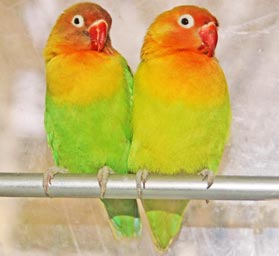
The bird type commonly referred to as Lovebirds is comprised of a very diverse and colorful group of parrots from Africa. It is so-called because if kept in pairs, the Lovebirds constantly groom each other and sit as close together as possible when sleeping or resting. This species is short and thick-bodied and measures about 5 to 6 inches long from head to tail.
Lovebirds as Pets
Wild Lovebirds are found in various locations of the African continent. However, Lovebirds have been kept as pets for over 100 years. They are very ideal as pets because of their playful and inquisitive nature especially when they have been hand-raised. Its size makes it very convenient to be kept in cages even in apartment living. Many experts believe that Lovebirds cannot talk, but some people swear that they have heard Lovebirds mimic talking.
Lovebirds are very popular pets since they don’t take up much space and are not as noisy as the larger parrot species. They are also quite hardy and don’t suffer much from many illnesses as long as they are kept clean and fed a nutritionally balanced diet. The cage should also be of the right size with accessories such as seed and water containers, perches and toys. Lovebirds are very playful and clownish and would need the appropriate place to stage their antics.
It is a common belief that Lovebirds must be kept in pairs. This is actually not true. A single Lovebird makes a better pet because it bonds to the owner rather than to another Lovebird. However, if the owner believes that he/she would be unable to provide all the required time and attention, the presence of a companion would prevent boredom and keep the birds happy.
There are numerous species of Lovebirds. It is not necessary to interbreed species to get new colors as color mutations occur within the same species. Lovebirds are not sexually dimorphic or the sex cannot be determined just by looking at it. Sex is usually determined through DNA testing.
Lovebirds can be bred either in a large aviary group or by individual pairs in separate breeding cages. Whether or not they are breeding, diet must include fresh whole foods, wheatgrass, corn on the cob, sprouted beans and seeds, brown rice as well as other vegetables and grains. Cuttlebone and plenty of water should likewise be regularly provided.
Lorikeets or Lorries also belong to the parrot family. Its numerous varieties can be divided mainly as the small Australian Lorikeets and the larger Tropical Lorikeets. It is a parrot-type birds that is playful and energetic and eats nectar and fruits rather than seeds in its natural environment. Thus, a pet Lorrie would require a specialized diet of nectar mix, fruits, vegetables and seeds.
Lorries are known to be very untidy eaters and spoils the cage and its surroundings with their large wet droppings. These birds require a diligent owner who is willing to clean the cage daily to prevent bacterial infections. Lorries are very susceptible to bacterial and yeast contamination from their food and cage.
The smaller varieties make better pets because of their soft bite while the larger Lorries are highly intelligent and make excellent pets as well for those seeking a playful and energetic bird. Lorries make good talkers but can become extremely noisy. This can be tempered by continuing obedience training. They are also known for their tremendous mimicking ability and will often imitate household appliances such as a telephone or microwave.
The cage of pet Lorries should allow them to move around freely and should have toys that would help them entertain themselves. Small Lorries can be successfully bred in both large communal aviaries and in suspended single pair cages. Larger Lorries demand an aviary that is not less than four to six meters long and one to two meters high.